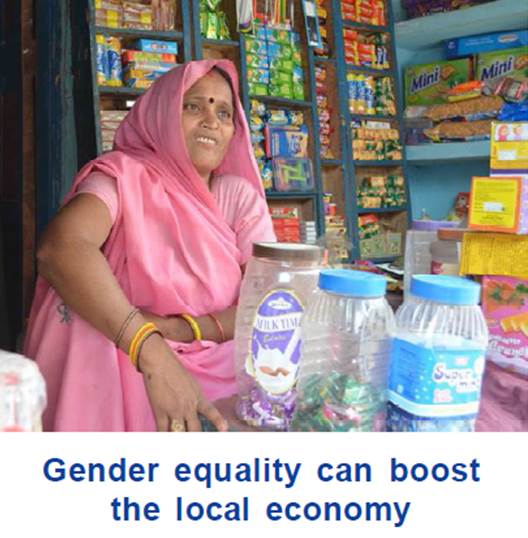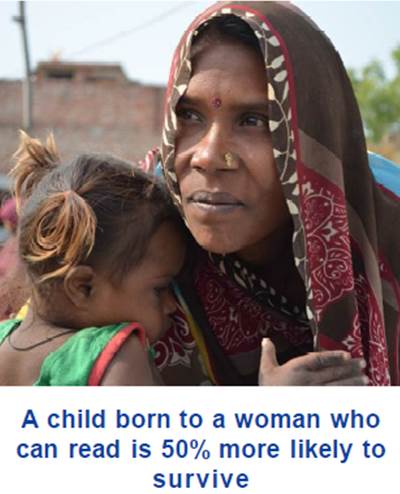|
Gender Mainstreaming in SDGs I t is indisputable that over the past fifteen years the Millennium Development Goals (MDGs) have contributed to the advancement of women and girls - particularly in the area of maternal health where mortality rates have been halved and in access to primary education where the global gender gap has virtually closed. However, many argue that the MDGs could and should have done
more to improve the status of women and girls. Several issues critical
not only to women’s progress, but also to the overall prosperity and
stability of women such as child marriage, violence against women and
valuation of women’s work were overlooked in the MDGs. closed. However, many argue that the MDGs could and should have done
more to improve the status of women and girls. Several issues critical
not only to women’s progress, but also to the overall prosperity and
stability of women such as child marriage, violence against women and
valuation of women’s work were overlooked in the MDGs.
Similar to the Millennium Development Goals (MDGs), the new Sustainable Development Goals decided in the year 2015 are to guide the setting of priority goals, the mobilisation of global resources towards shared objectives and enhanced accountability for realising a common vision of sustainable development. The SDGs are providing frameworks for eradicating poverty, creating sustainable consumption and production patterns, ensuring sustainable water and energy access while protecting the environment, promoting transparent and accountable governance, achieving equality including gender equality and human rights and ensuring access to high quality education and health care, essential laws, services and infrastructure. The SDGs provide a critical opportunity to dramatically expand upon the progress of women and girls and increase our collective ambition for achieving gender equality. Importantly, SDGs include a specific gender equality goal with targets that are considerably more comprehensive than those included in the MDG framework. A stand-alone gender equality goal is retained in parallel to the mainstreaming of gender equality in all other goals because gender equality is a prerequisite for achieving progress in other development goals and achieving gender equality is an important human rights goal in itself. Three critical target areas have been identified for a stand-alone gender equality goal - freedom from violence against women and girls, gender equality in the distribution of capabilities and gender equality in decision-making in all spheres of public and private life. Further, issues related to the advancement of women and girls have been integrated throughout the post 2015 goals. Integrating Gender Sensitivity in SDGs Poverty eradication has been kept as the first sustainable development goal. One of the major targets is to ensure that by 2030 all men and women, particularly poor and vulnerable women should have equal rights to economic resources as well as access to basic services, ownership and control over land, inheritance, natural resources and financial services. The aim of this goal is to create sound frameworks at national, regional and international levels based on pro-poor and gender sensitive development strategies to support accelerated investment in poverty eradication actions. Agriculture is the largest employer in the world, providing livelihoods for 40 per cent of today’s global population. But time and again it has been seen that women farmers do not have the same access to resources as men farmers. If women farmers had the same access to resources as men, the number of hungry people could be reduced by up to 150 million 1. The goal on nutrition and food security focuses on addressing the nutritional needs of adolescent girls, pregnant and lactating women. It also aims to double the agricultural productivity and incomes of small scale food producers in particular women by 2030.
Globally, adolescent girls and young women face gender-based inequalities, exclusion, discrimination and violence which puts them at an increased risk of acquiring lot of health problems especially HIV. Also, 103 million youth worldwide lack basic literacy skills and more than 60% of them are women. In India itself, out of the total illiterate population almost 68% are women. In developing regions as a whole, 95 girls were enrolled in primary school for every 100 boys in 2007, compared to 91 in 1999 2. By 2012 the enrollment ratios were the same for boys as for the girls3. Significant gaps still remain in some regions. In South and West Asia, 66 per cent of out-of school children are girls4. In some regions, gaps in secondary education parity are widening, such as in sub-Saharan Africa, where the ratio of girls’ to boys’ enrolment in secondary education fell from 82 in 1999 to 79 in 20075. Educating girls and women has a positive multiplier effect on progress across virtually all development areas.The MDG campaign had been driven by both national and international efforts, resulting in a considerably larger number of girl-child enrolment in school today compared with 15 years ago. But still there is a lot to be done. The need of the hour is to focus equally on secondary and higher education of girls. Two SDGs namely ‘Ensure healthy lives and promote well being for all at all ages’ and ‘Ensure inclusive and quality education for all and promote lifelong learning’ have tried to inlay gender equality in both education and health sector. Infant mortality is still ubiquitous especially in South Asia and Africa. It has been seen that children of educated mothers, even mothers with only primary schooling are more likely to survive than children of mothers with no education. Thus a lot of emphasis has been given on educating the girl child and women in the SDGs. The target is to ensure that all girls and boys have access to quality early childhood development, preprimary education, primary and secondary education. Also one of the major targets is to eliminate gender disparity in education and ensure equal access to all levels of education and vocational training. In the field of water and sanitation, the target is to achieve access to adequate and equitable sanitation and hygiene to all and end open defecation, paying special attention to the needs of women and girls in vulnerable situations. Gender mainstreaming is vital to achieve broader development goals. There is an urgent need to perceive, review and address the shortcomings of gender mainstreaming as we strive to eliminate extreme poverty and hunger and achieve universal access to education and sexual and reproductive health, decent work, equal access of resources, an end of violence against women and girls and women’s full participation in decision making. Gender responsive evaluation should be conducted from time to time to understand the gender-wage gap, access to and control over productive and financial means, time poverty, equal sharing of responsibilities at the household level and women’s equal representation at all levels of decision making in the private and public spheres. Global agreement to include gender equality in SDGs is a very positive development and signals a recognition by member states that gender inequality not only decreases the likelihood of achieving the other goals, but also that advancing gender equality and women’s empowerment has a positive impact on progress made on each of the other goals. q Parul Verma References 1 Sustainable Development Knowledge Platform, 2015 2 MDGs Report, United Nations, 2009 3 Sustainable Development Knowledge Platform, 2015 4 UNESCO, "Education for All Global Monitoring Report", 2008 5 UNICEF.Children and the Millennium Development Goals. 2007
|